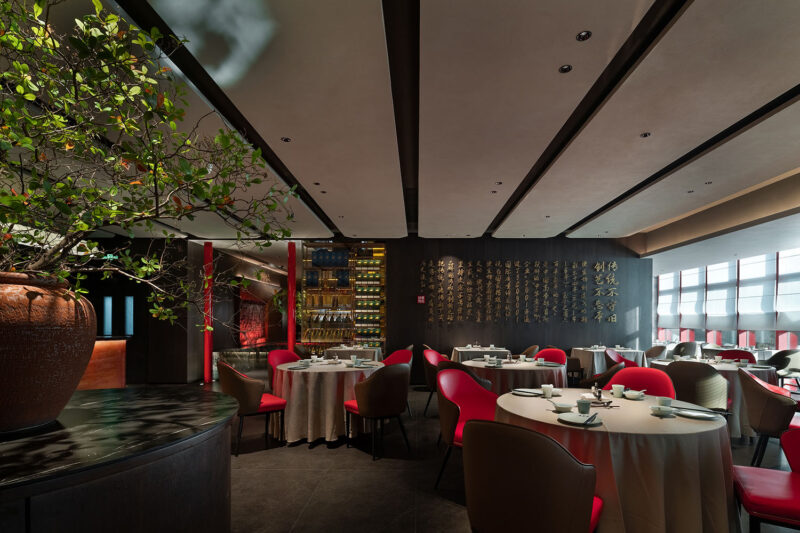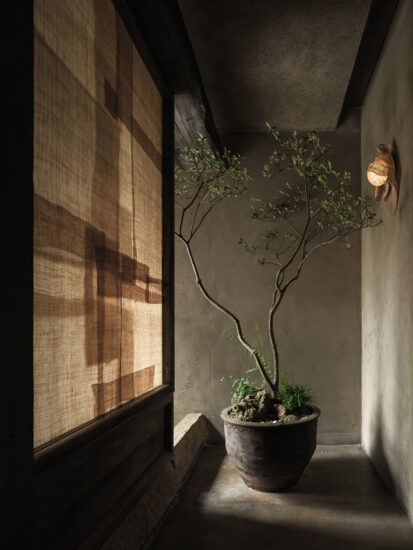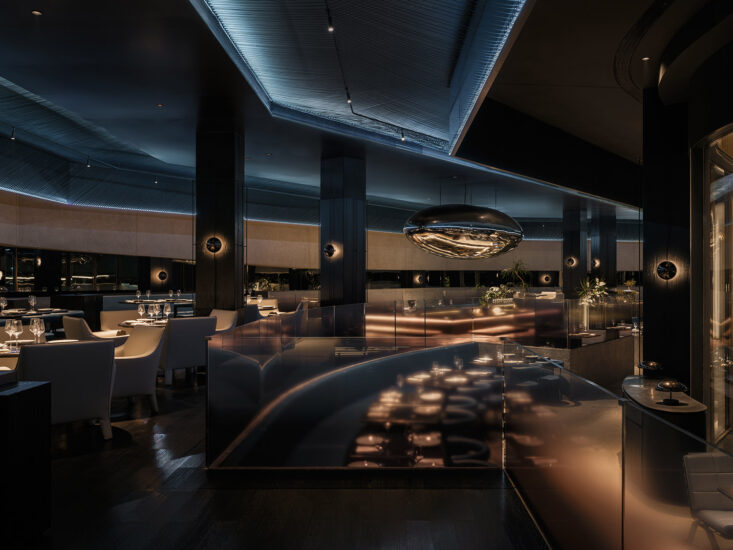项目背景:十年磨一剑的老字号情怀
Background of the project: adecade ofhoning thespirit of atime-honoredbrand
华洲距离泉州市区仅一桥之隔,开车不过十来分钟。然而,吴记华洲咸饭从华洲走向鲤城区,却用了整整十年时间。
Huazhou is only one bridge away from downtown Quanzhou, and it takes only ten minutes by car. However, it took Wu Ji Huazhou Savory Rice a full decade to move from Huazhou to Licheng District.
∇ ©侯鸿伟 ©Hongwei Hou
2024年3月,吴记华洲咸饭的年轻主理人小吴找到我们,表达了想在鲤城区开设分店的想法。尽管他对新店的具体模样没有清晰的构想,但内心深处有一种模糊的期待——那是一种对老字号精神的坚持,对本地文化的自豪,以及对温暖街区的向往。
In March 2024, Wu, the young manager of Wu Ji Huazhou Savory Rice, approached us with the idea of opening a branch in Licheng District. Although he did not have a clear vision of exactly what the new store would look like, there was a vague expectation deep down ——that of an adherence to the spirit of time-honored brand, pride in the local culture, and a longing for a warm neighborhood.
∇ 区位图 ©侯鸿伟 李微 District Map © Hongwei Hou Wei Li
吴记华洲咸饭的故事始于1997年。当时小吴的父亲老吴推着一辆三轮车,在华洲水产批发市场售卖咸饭和汤。2000年,店铺有了固定的门面,但直到2013年鱼市场搬迁,吴记华洲咸饭选择留在华洲,逐渐成为当地人心中“好吃的咸饭”代名词。如今老店的营业时间从白天十点半延续到凌晨三点,老吴夫妇依然坚持守夜,只为那些深夜光顾的老主顾们点一盏温暖的灯。
The story of Wu Ji Huazhou Savory Rice began in 1997. At that time, Wu’s father, old Wu, pushed a tricycle to sell savory rice and soup at the Huazhou Wholesale Fish Market. 2000, the store had a permanent storefront, but until the fish market was relocated in 2013, Wu Ji Huazhou Savory Rice chose to stay in Huazhou, and gradually became synonymous with “delicious savory rice” in the hearts of the locals. Nowadays, the business hours of the old store extend from 10:30 in the daytime to 3:00 in the morning, and Mr. and Mrs. Wu still insist on keeping watch at night, just for the old customers who patronize the shop late at night to light a warm lamp.
∇ 品牌编年史和店铺变迁图 ©陈与安品牌策划公司 Brand chronicle and store evolution ©Chen & An Branding Agency
设计挑战:从模糊到清晰的空间叙事
Design Challenge: From Ambiguity to Clear Spatial Narrative
项目初期,设计任务书几乎是一张白纸。我们从零开始,通过与主理人小吴的多次沟通和对场地的实地考察,逐渐梳理出设计的核心脉络。我们意识到,这个项目不仅仅是一个餐厅设计,更是一次对在地文化与品牌历史的深度挖掘。
At the beginning of the project, the design assignment was almost a blank sheet of paper. We started from scratch, and gradually sorted out the core of the design by communicating with the lead manager,Wu, and conducting site visits. We realized that this project was not just a restaurant design, but also a deep excavation of the local culture and brand history.
为了寻找灵感,我们一同走访了泉州的老街巷——文庙、庄府巷、花巷、金鱼巷、泮宫、中山街和西街,甚至前往博物馆寻找历史的“缘分”。这些走访让团队逐渐明确了设计方向:我们想要打造一个充满市井气息与烟火气的空间,同时将闽南传统建筑元素与现代设计语言相结合,赋予老字号新的生命力。
In order to find inspiration, we visited the old streets and alleys of Quanzhou – Wenmiao, Zhuangfu Alley, Flower Alley, Goldfish Alley, Pangong, Zhongshan Street and Xijie Street, and even went to a museum to find the “fate” of history. These visits allowed the team to clarify the design direction: we wanted to create a space full of marketplace atmosphere and fireworks, while combining traditional architectural elements of southern Fujian with modern design language to give new vitality to the old shops.
∇ 中山路 ©侯鸿伟 Zhongshan Road © Hongwei Hou
∇ 文庙 ©侯鸿伟 © Hongwei Hou
∇ 关帝庙 ©侯鸿伟 © Hongwei Hou
∇ 忠惠蔡公祠 ©侯鸿伟 © Hongwei Hou
设计策略:在地性与当代性的平衡
Design Strategy: Balancing Locality and Contemporaneity
在设计过程中,团队面临的最大挑战是如何平衡传统与当代的关系。闽南传统建筑以红砖、燕尾脊、出砖入石等元素闻名,但这些厚重的历史符号是否适合一家快餐店?我们最终选择以现代手法重新诠释传统元素。
During the design process, the biggest challenge the team faced was how to balance the relationship between tradition and contemporaneity. The traditional architecture of Southern Fujian is famous for elements such as red bricks, swallow-tail ridges, andthe integration of brick and stone, but are these heavy historical symbols suitable for a fast food restaurant? We ultimately chose to reinterpret the traditional elements in a modern way.
∇ ©侯鸿伟 ©Hongwei Hou
此处内容需要权限查看

















